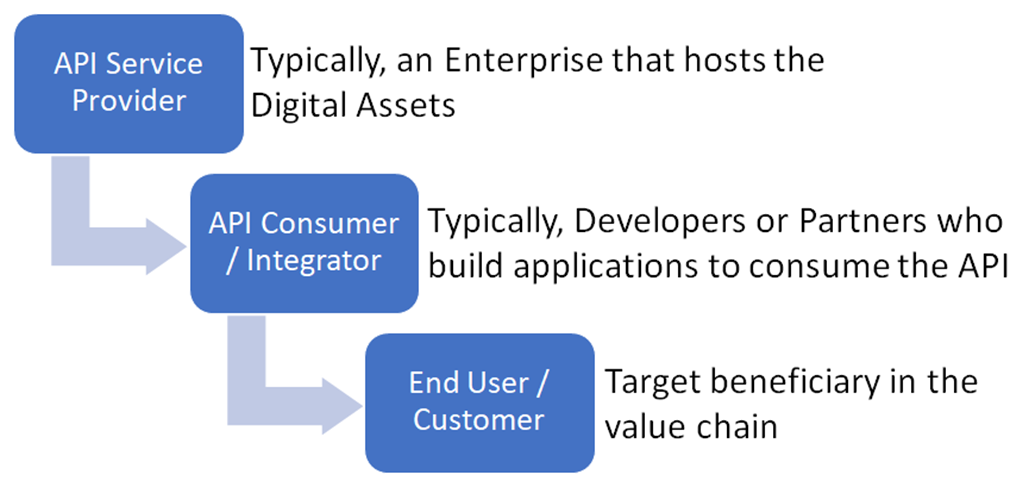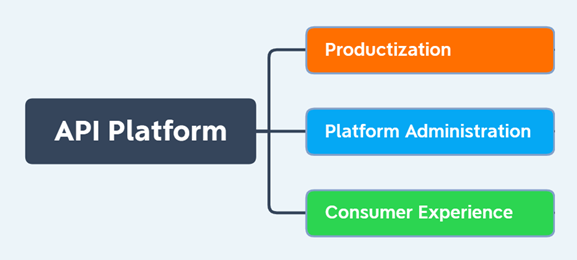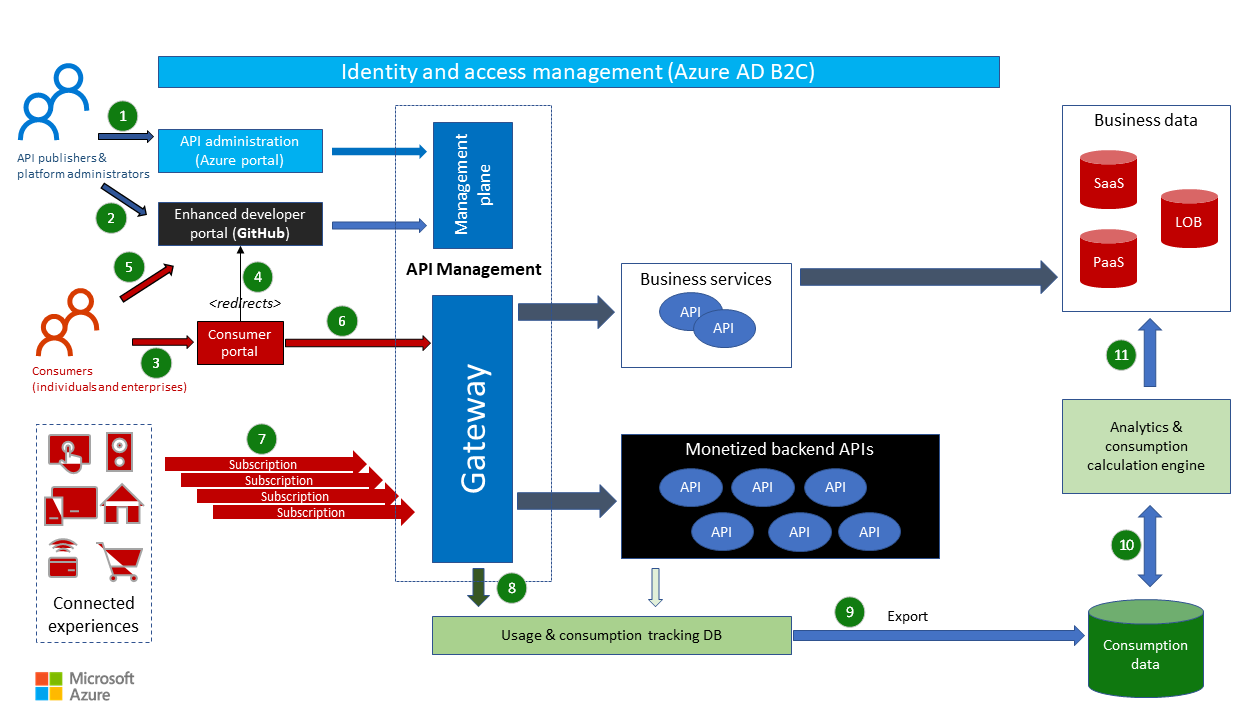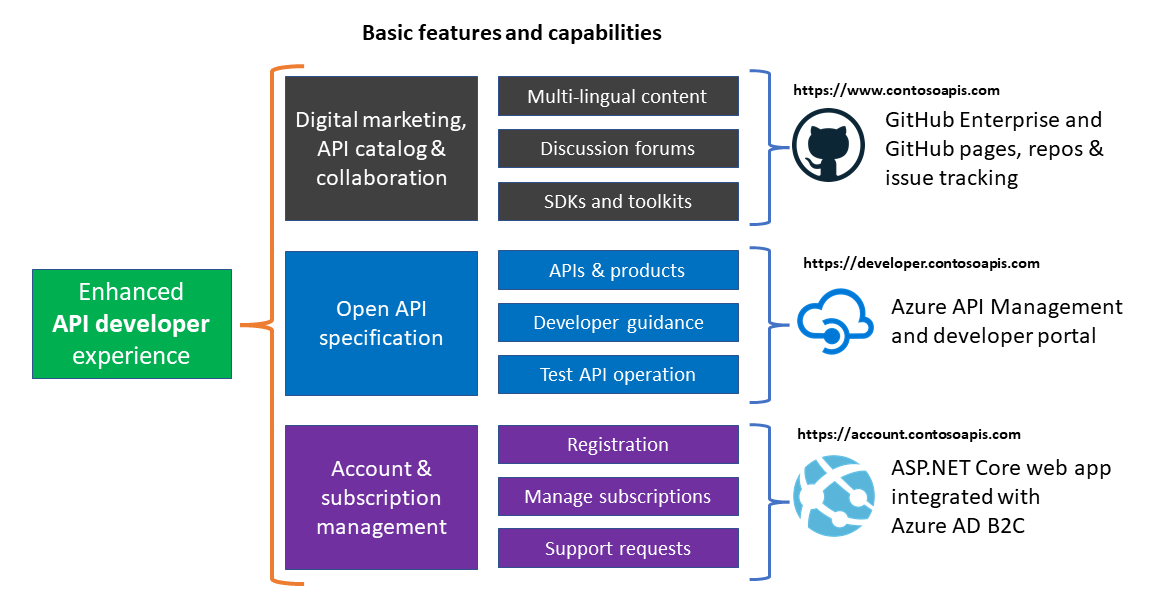Note
Access to this page requires authorization. You can try signing in or changing directories.
Access to this page requires authorization. You can try changing directories.
As the publisher of APIs, you need a website that effectively markets your APIs and helps customers to differentiate between offerings. When they've selected APIs, you need to be able to give access only to authenticated users, manage consumption, and deliver accurate invoices for use. This example scenario shows how you can use Azure service and GitHub to create a platform that does all of this and more.
Architecture
Download a PowerPoint file of this architecture.
Dataflow
The solution primarily consists of the following building blocks:
Monetized back-end APIs & API gateway. At the core of the solution is the set of back-end APIs that are monetized. The consumers, such as users, applications, and devices, access the API platform through an API gateway. The gateway throttles requests and applies rate leveling as needed.
Consumer portal and applications. The consumers of the API platform browse the API offerings, register, and then generate subscription keys to access the various API end points. They can update information about their accounts and billing by using the account management features of the solution.
Administrative portals and applications. Platform administrators publish the list of API products, their pricing, and rate plans. These portals also offer rich analytics on the use of the various API products, which help in troubleshooting issues and offering support services.
Line-of-business services. These services are required to deliver the functionalities of the consumer portals and applications and to support the various user journeys that are supported in the solution.
API consumption tracking and charges calculation engine. The API consumption reports, captured at the API gateway layer, are periodically exported to a separate data store. Scheduled jobs run on this data to calculate the charges that apply to any consumer account, based on its list of subscriptions and associated pricing model.
The processing sequence in this solution flows as follows:
The API publisher imports the API specifications by using the Azure portal, groups them by product, and publishes them.
The API publisher updates the product-related marketing information in the corresponding GitHub repository.
The API consumer accesses the marketplace portal, browses the various products, and selects a specific API service.
When the consumer attempts to view more information about the API service, the consumer portal redirects the consumer to the enhanced developer portal, which is hosted on GitHub and uses GitHub Pages.
The consumer can browse different API specifications, developer-related information, and even try invoking an endpoint by using a sample payload.
The consumer registers with the platform and then activates a subscription for the particular API service that they're interested in using.
The consumer makes use of the API service in their apps or devices.
The invocation of the API generates metrics about its use and consumption, which are stored by Azure in tracking databases.
The consumption data is periodically exported and saved to a custom database, typically a data lake, for further analysis.
A back-end job calculates charges from the consumption data and the various subscriptions.
The invoice and payment-related information is stored within the accounting database. This information is used to calculate the revenue for the service.
Components
The solution is composed of the following software as a service (SaaS) offerings:
Azure API Management is a managed platform as a service (PaaS) that allows organizations to publish APIs to both internal and external consumers. In this architecture, API Management serves as the central API gateway that decouples API hosting from the published gateway. It provides governance layers that have policies for rate limits and quotas, and it includes a developer portal for API documentation. For more information, see Gateway Routing pattern.
GitHub is a software development platform that provides version control and collaboration features. In this architecture, GitHub hosts the enhanced developer portal. It provides the following features:
GitHub Pages is a static site hosting service that enables your enterprise to host a rich HTML-based website directly from within a GitHub repository. In this architecture, it provides API documentation and interactive experiences for API consumers.
GitHub Discussions is a forum-style space within a repository that enables open-ended conversations and community engagement. GitHub Issues is a task-tracking system used to report bugs, suggest features, and manage development work collaboratively. In this architecture, both features enable API consumers and developers to exchange ideas, report problems, and contribute to the API ecosystem.
Azure App Service is a fully managed compute platform for hosting custom web applications. In this architecture, App Service hosts the consumer portal and account portal components that provide the marketplace experience, user registration, and account management features for API consumers.
Microsoft Entra External ID is an extension of Microsoft Entra ID that your application can use to manage external customer or partner identities for access and authorization. In this architecture, Microsoft Entra External ID handles user registration, authentication, and identity management for API consumers. These tasks support integration with identity providers and the Microsoft identify platform.
Scenario details
The success and adoption of any API platform is largely dependent on how highly it's regarded in the marketplace. Beyond the digital assets offered by the platform, the ease of finding APIs and the ease of using them has a large effect on whether customers use a platform. Customers must be able to find documentation and receive support for issues. The platform should also facilitate community contribution to help your customers shape your APIs to their needs. As the publisher of APIs, you need a website that effectively markets your APIs and helps customers to differentiate between offerings. When they've selected APIs, you need to be able to give access only to authenticated users, manage consumption, and deliver accurate invoices for use. This example scenario shows how you can use Azure service and GitHub to create a platform that does all of this and more.
Potential use cases
You can use this solution to make it easy for API developers to:
- Discover and understand your API product offerings.
- Subscribe and integrate with your various applications and channels.
- Get help, troubleshoot problems, and remediate issues.
- Promote community contribution and exchange ideas and knowledge.
API value chain

At the top of the value chain is the API service provider. Next are the API consumers or integrators, who design and build the experiences for the eventual target consumers. End users and customers are the final beneficiaries in the value chain.
API developer experience
Download a PowerPoint file of this diagram.
The API developer experience features three portals:
Consumer portal. The consumer portal serves as a marketing website that showcases the various API products that are offered by the enterprise.
Developer portal. The developer portal provides third-party developers with documentation about the various API services and how to use them in their applications.
Account portal. Registered users manage their subscriptions and perform other account-related activities by using the account portal.
Functional requirements
At a high level, the functional requirements for an enterprise-scale API platform fit into three categories, namely productization, platform administration, and consumer experiences.

The following sections further describe the capabilities within each feature area.
Productization
The goal of productization is to identify and define the monetized APIs, their management, and a strategy for selling them as digital products. As a result, it covers:
- Capabilities, such as identifying variants of the products and their corresponding mapping to physical assets.
- A definition of the pricing and rate plans, along with the necessary metadata.
- Content that must be created for driving the consumer experience.
Productization comprises the following capabilities:
API products. This catalog of APIs is made available to the consumers. A product might be offered for purchase or as a free service.
Variants. The developer experience should identify the variants of any API product that's monetized.
Pricing plans. Define the various pricing plans to make it attractive for the consumers.
Taxonomy and content. Define and create the content—textual, PDFs, images, and so on—that's required for the marketing strategy for these API products.
Physical assets. This comprises the actual cloud services that are part of the specific API product and their corresponding lifecycle management. Consider the operations cost of maintaining these services while deriving the pricing plans.
Platform administration
Platform administration focuses on the overall hosting, management, and governance of the API platform. It also provides an end-to-end solution for administration of the various line-of-business applications and services. Major areas of focus are subscription management, billing, and invoicing. Platform administration also provides generation of business insights and analytics to present the overall health of the service, including its financial and operational aspects.
Platform administration comprises the following capabilities:
User registration. Identify how users register with the platform. Define any approval workflows that are necessary, depending on the user segment.
API catalog. Identify the API assets that are published through API Management. Apply policies to control access and use of the APIs. Manage the subscriptions of the users.
Insights and analytics. Capture telemetry data to generate various metrics. Visualize the data by using different dashboards, such as Power BI, to derive the various insights that are required for business and IT decision makers.
Billing and invoicing. Define the workflows that are related to subscriptions, order management, billing, and invoicing.
Support. Establish tools and processes to handle support requests.
Consumer experience
The adoption of the API platform is heavily dependent on how easily consumers can:
- Discover the APIs that they need.
- Review the specification and technical content by browsing through the developer portal.
- Register to subscribe.
- Pay for the API products that they selected.
- Start using the APIs in their applications.
A consumer experience is typically delivered through a web portal, a mobile app, or both. You can use Microsoft Entra External ID to facilitate user registration and identity management. Microsoft Entra External ID includes support for OpenID identity providers, such as Microsoft and Google.
Consumer experiences comprise the following components:
Product (API) catalog. Create a marketplace experience for users, both anonymous and registered.
Account and subscription management. Establish procedures for registering and signing in based on the types of users whom you expect to use your API. Support user preferences, such as the use of existing social identity providers. Allow for self-service subscription management, activation and deactivation services, and payment of charges as invoiced.
User interface (UI) / User experience (UX). Identify and define the experiences for the channels that you support for end-user experiences. Include multi-device, multi-form-factor capabilities, along with modern UI design. Enrich the experience through usability studies.
Considerations
These considerations implement the pillars of the Azure Well-Architected Framework, which is a set of guiding tenets that can be used to improve the quality of a workload. For more information, see Microsoft Azure Well-Architected Framework.
The components in this scenario address issues of performance, reliability, and security.
API Management supports autoscaling, which quickly expands API Management capabilities in response to growing numbers of incoming requests. API Management also supports zone redundancy and multi-region deployments to provide resiliency and high availability. For more information about zone redundancy, see Availability zone support for Azure API Management. For more information about API Management security, see Azure security baseline for API Management.
App Service is a fully managed platform as a service that features built-in security and autoscaling with an SLA that promises high availability. App Service is ISO, SOC, and PCI compliant, and it supports authenticating users with Microsoft Entra ID, Google, Facebook, Twitter, or Microsoft account. With App Service, you can also create IP address restrictions.
Microsoft Entra External ID offers high availability and scales to supporting hundreds of thousands of users. Microsoft Entra External ID supports OpenID Connect and multiple identity providers so that customers can choose their preferred provider. Microsoft Entra External ID also supports application-based and policy-based multifactor authentication, adding additional layers of security. For more information about Microsoft Entra External ID, see Secure your apps using External ID in an external tenant
GitHub makes security reviews an automated part of code reviews, scanning every new commit for potential security issues. This service helps you to discover problems as soon as they're offered as additions to the code base. GitHub security allows you to customize searches for security concerns and integrate third-party scanning engines. For more features and details, see Security on GitHub.
Cost Optimization
Cost Optimization is about looking at ways to reduce unnecessary expenses and improve operational efficiencies. For more information, see Design review checklist for Cost Optimization.
You can develop the consumer portal by using the Team or Enterprise pricing plan for GitHub. Refer to the feature matrix to identify which plan best suits your enterprise.
For API Management, you can use the Standard or the Premium tiers. To better understand the differences between the tiers, see API Management pricing options.
For Azure App Service, refer to the pricing options that are available for Windows and Linux environments for hosting your applications.
Contributors
This article is maintained by Microsoft. It was originally written by the following contributors.
Principal author:
- Subhajit Chatterjee | Principal Software Engineer, Industry Clouds
Next steps
- Monetization with Azure API Management
- Overview of the developer portal in Azure API Management
- Self-host the API Management developer portal
- Self-hosted gateway
- Getting started with GitHub Pages

